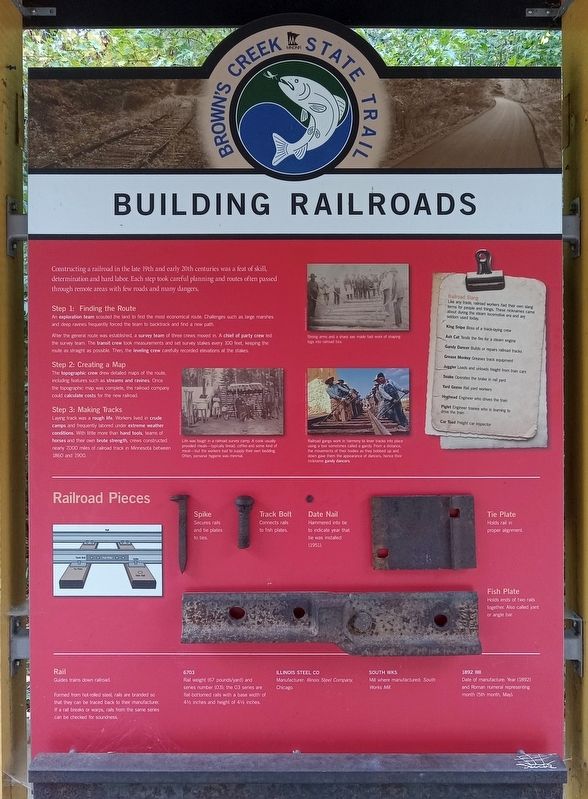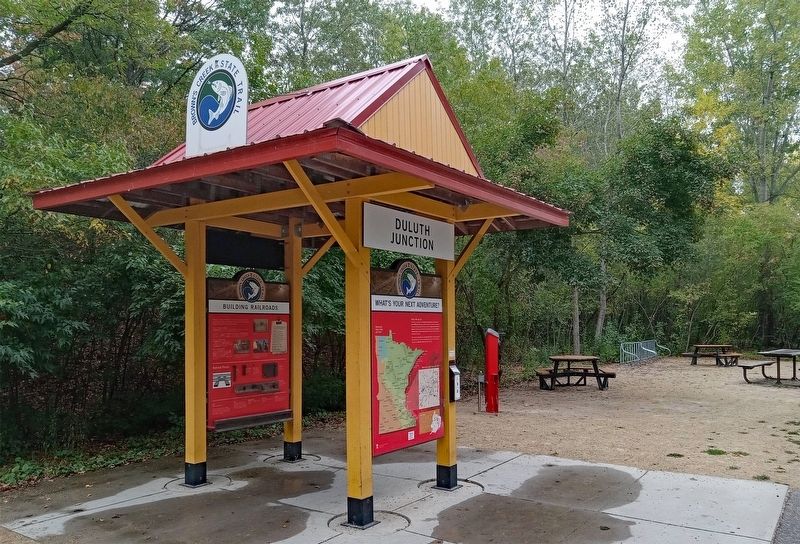Grant in Washington County, Minnesota — The American Midwest (Upper Plains)
Building Railroads
— Brown's Creek State Trail —
Constructing a railroad in the late 19th and early 20th centuries was a feat of skill, determination and hard labor. Each step took careful planning and routes often passed through remote areas with few roads and many dangers.
Step 1: Finding the Route
An exploration team scouted the land to find the most economical route. Challenges such as large marshes and deep ravines frequently forced the team to backtrack and find a new path.
After the general route was established, a survey team of three crews moved in. A chief of party crew led the survey team. The transit crew took measurements and set survey stakes every 100 feet, keeping the route as straight as possible. Then, the leveling crew carefully recorded elevations at the stakes.
Step 2: Creating a Map
The topographic crew drew detailed maps of the route, including features such as streams and ravines. Once the topographic map was complete, the railroad company could calculate costs for the new railroad.
Step 3: Making Tracks
Laying track was a rough life. Workers lived in crude camps and frequently labored under extreme weather conditions With little more than hand tools, teams of horses and their own brute strength, crews constructed nearly 7,000 miles of railroad track in Minnesota between 1860 and 1900.
Life was tough in a railroad survey camp. A cook usually provided meals—typically bread, coffee and some kind of meat—but the workers had to supply their own bedding. Often, personal hygiene was minimal.
Strong arms and a sharp axe made fast work of shaping logs into railroad ties.
Railroad gangs work in harmony to lever tracks into place using a tool sometimes called a gandy. From a distance, the movements of their bodies as they bobbed up and down gave them the appearance of dancers, hence their nickname gandy dancers.
Railroad Slang
Like any trade, railroad workers had their own slang terms for people and things. These nicknames came about during the steam locomotive era and are seldom used today.
King Snipe Boss of a track-laying crew
Ash Cat Tends the fire for a steam engine
Gandy Dancer Builds or repairs railroad tracks
Grease Monkey Greases track equipment
Juggler Loads and unloads freight from train cars
Snake Operates the brake in rail yard
Yard Geese Rail yard workers
Hoghead Engineer who drives the train
Piglet Engineer trainee who is learning to drive the train
Car
Toad Freight car inspector
Railroad Pieces
Spike
Secures rails and tie plates to ties
Track Bolt
Connects rails to fish plates
Date Nail
Hammered into tie to indicate year that tie was installed (1951).
Tie Plate
Holds rail in proper alignment
Fish Plate
Holds ends of two rails together. Also called joint or angle bar.
Rail
Guides trains down railroad
Formed from hot-rolled steel, rails are banded so that they can be traced back to their manufacturer. If a rail breaks or warps, rails from the same series can be checked for soundness.
6703
Rail weight (67 pounds/yard) and series number (03); the 03 series are flat-bottomed rails with a base width of 4½ inches and height of 4½ inches.
Illinois Steel Co
Manufacturer: Illinois Steel Company, Chicago.
South Wks
Mill where maufactured: South Works Mill.
1892 IIIII
Date of manufacture : Year (1892) and Roman numeral representing month (5th month, May).
Topics. This historical marker is listed in this topic list: Railroads & Streetcars. A significant historical year for this entry is 1860.
Location. 45° 4.608′ N, 92° 54.014′ W. Marker is in Grant, Minnesota, in Washington County. Marker can be reached from Dellwood Road (State Highway 96) west of Kimbro Avenue N. The marker is at Duluth Junction, the western terminus of the Brown's Creek State Trail where it intersects with the Gateway State Trail. Touch for map. Marker is at or near this postal address: 10300 Dellwood Road, Stillwater MN 55082, United States of America. Touch for directions.
Other nearby markers. At least 8 other markers are within 5 miles of this marker, measured as the crow flies. From Rails to Trails (here, next to this marker); Historic Span of an Iron Bridge (approx. 2.6 miles away); Brown's Creek Revival (approx. 2.8 miles away); Bridging Brown's Creek (approx. 3.4 miles away); Restoring Oak Woods and Prairies: Why Do It? (approx. 4.3 miles away); Pine Point County Park (approx. 4.3 miles away); Tamarack House (approx. 4.6 miles away); Indian Battleground (approx. 4.6 miles away). Touch for a list and map of all markers in Grant.
Credits. This page was last revised on October 2, 2023. It was originally submitted on September 19, 2023, by McGhiever of Minneapolis, Minnesota. This page has been viewed 62 times since then and 10 times this year. Last updated on September 29, 2023, by McGhiever of Minneapolis, Minnesota. Photos: 1, 2. submitted on September 19, 2023, by McGhiever of Minneapolis, Minnesota. • J. Makali Bruton was the editor who published this page.

